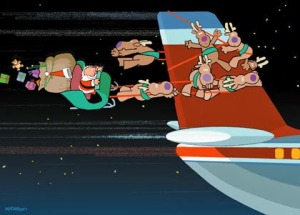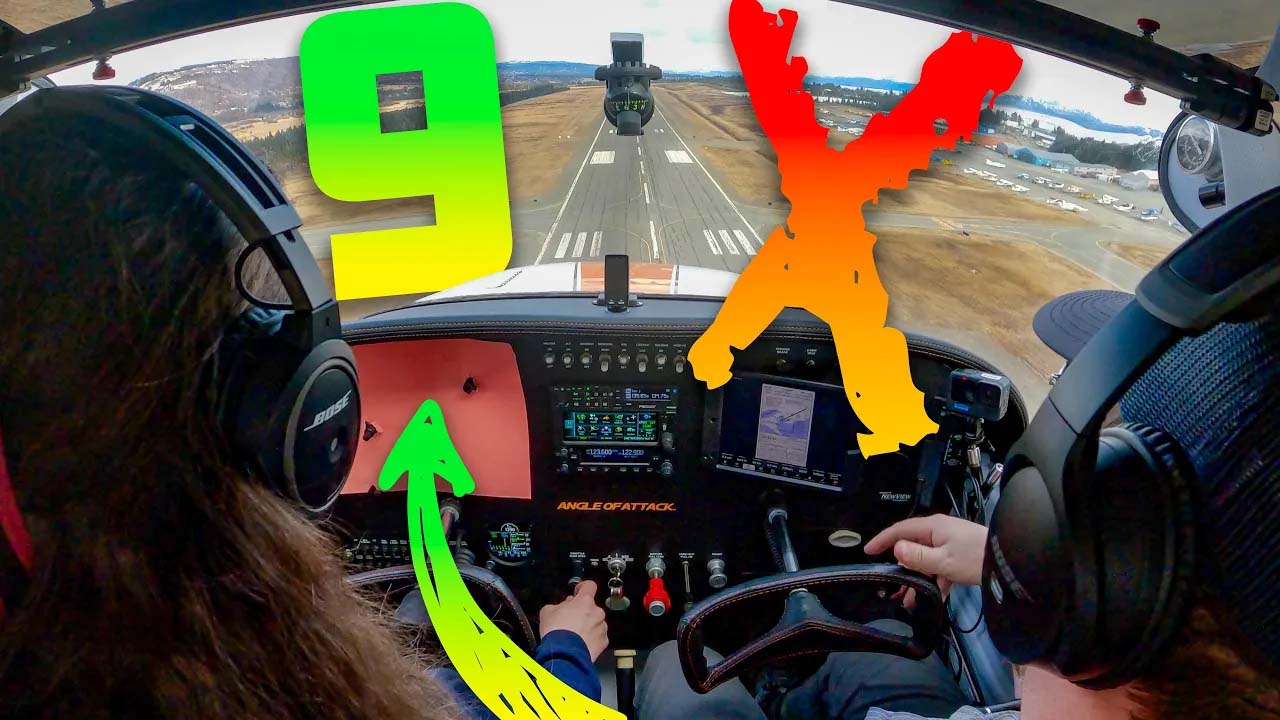


Today’s Flight Plan
On this very special Christmas episode, we talk about many of the FAQs surrounding Santa:
- How do reindeer fly?
- Does Santa’s sleigh produce thrust?
- How can Santa deliver all those presents in one night?
- Where did Santa learn to fly?
- How can so many gifts fit in one sleigh?
- What kind of instrument panel does Santa have?
- What is Santa’s flight plan?
Gather the kids around so they can learn a thing or two about Santa. After all, Santa is one of the oldest aviators around.
Credits
Music
Big thanks to Atrasolis for providing the great music for our podcast. Please check them out on their Facebook Page or SoundCloud and get the music you’ve heard for free.
Crew
Major thanks to the amazing Angle of Attack Crew for all their hard work over the years. Our team works incredibly hard, and they’re very passionate about what they do.
Now What?
iTunes Subscribe
Want to get regular updates through iTunes? This is the easiest way to automatically download your podcast, and take it on the go. Make sure to SUBSCRIBE HERE.
Email Signup
Want us to let you know via email when episodes of AviatorCast are released? We can do that, too. SIGNUP ABOVE.
Get Started Today!
Want to get started with some of our video training? Go to our main page and signup for Aviator90 (our basic and free course) or other pay products we have.
Transcript
[transcript]
Now de Havilland, now Diamond, now Piper and Vance. On Cessna, on Cirrus, on Douglas and Beechcraft. This is AviatorCast episode 49.
Calling all aviators, pilots and aviation lovers, welcome to AviatorCast, where we close the gap between real aviation and flight simulation. Climb aboard, buckle up and prepare for takeoff. Here’s your host, Chris Palmer!
Chris: Welcome, welcome, welcome aviators. You’ve landed at AviatorCast. My name is Chris Palmer. I’m an aviator. Like Santa, Lindberg, Yeager or the Wrights, I love flying. I’m sure you are much the same enjoying the perspective, only seeing from a cockpit aloft. I’m the founder and owner of Angle of Attack, a flight training company which is bringing you this podcast today. AviatorCast is weekly podcast where we talk about the spirit of the aviator. We believe flying is an art form, one that we have to continually practice and master. This mastery is gained through a focus on continual learning, human factors, humility, and a commitment to excellence. Show notes, transcript, community discussion, and links for this episode can be found by simply going to AviatorCast.com.
So welcome to this, the 49th episode of AviatorCast. It is that wonderful time of year. It is Christmas, and Christmas is coming right up. So we have kind of a Christmassy episode lined up for you guys today. Before we get into that, we have a review all the way from the United Kingdom. The title is Inspirational and Matty Fab the reviewer gives us five stars. He says “Fantastic podcast combining both real world aviation and simulation. An absolute must for anyone with a keen interest in aviation and very inspirational for people like me who are currently mid PPL training. Keep up the top podcast Chris.”
Thanks Matty Fab for that wonderful review. It’s great to have you as one of our listeners and I really appreciate that. If you would like to leave a review for us, that is you the listener, yes you, go ahead and go to iTunes and leave a review there. We’d love to hear from you. You may even get your review read on the show. There’s a high likelihood of that happening.
So today, we are going to talk about the frequently asked questions about Santa Claus, who Santa Claus is. And as you know, Santa Claus is the oldest aviator. So ladies and gentleman, boys and girls gather around for the first ever Christmas episode of AviatorCast. Today we are going to be talking about the technical details of how Santa actually delivers all those presents everywhere in the world in one night. As you know, Santa is one of the oldest aviators around. He was flying presents all around long before the Wright brothers were tinkering like elves with what would be the first powered airplane. Even today, the speed at which Santa delivers gifts to all you boys and girls is special. He is faster than an SR-71 Blackbird, speedier than a Concord and perhaps even snappier than the space shuttle. This guy hauls presents around with amazing precision and accuracy. No matter the weather, this IFR-rated super aviator can spot land on your rooftop, drop in your chimney and unload his cargo in the twinkle of an eye. In this episode of AviatorCast, we are going to talk about how he does exactly that, once and for all dispelling some of the mysteries surrounding operations at North Pole Airways. So now we will go through some common questions about how Santa actually does what he does, and also how he came to be one of the best aviators around. I think you guys will really enjoy this insider information into who Santa Claus actually is.
How do a reindeer fly? We all know how an aircraft flies at least in theory. Add enough thrust to a machine that has a flyable wing and magic will happen. But truly this isn’t magic. Rather, it’s science, engineering and math working in harmony. How then do we explain flying reindeer? What properties of reindeer make it possible for these land-ridden creatures to fly? Much like an airplane and its components, we’ve got to take a deeper look at the anatomy of the reindeer. It probably won’t surprise you that the antlers themselves greatly contribute to their ability to fly.
Here is what happens. First, we start with the northern lights. Also known as the aurora borealis or just aurora, this phenomenon is a reaction of solar wind dust with our atmosphere that causes beautiful and awe-inspiring bands of primarily green and red energy. It is certainly a sight to behold. It’s no coincidence that the main colors of the aurora are green and red just like Christmas colors.
Back to our trusty reindeer. The pack of furry friends can often be seen grazing outside Santa’s workshop at the North Pole. During this time of eating and fraternizing while playing reindeer games, this magical energy from the northern lights is collected in each reindeer’s antlers over the months leading up to Christmas. When the big day nears, the reindeers are harnessed and yoked together. Last minute preparation takes place as a flurry of elves do menial tasks like polish the sleigh bells, tend to the reindeer hooves, shine Rudolph’s nose and brush the reindeer’s hair and fur.
Just before launch on Christmas Day, the reindeer eat special Christmas cookies made up by Mrs. Claus. These cookies have a very special ingredient that cannot be shared here as it is a closely guarded secret like Kentucky Fried Chicken’s 11 spices and herbs recipe or Coca-Cola’s delicious concoction. These cookies are like a delicious medicine that starts a physical and anatomical process of transferring all that stored aurora energy from the antlers to the whole body of the reindeer. As we know that there is no gravity in space, now this aurora energy that started in space makes this reindeer anti-gravity. Now the reindeer defy all laws of gravity that we are accustomed to here on Earth. They can fly to and fro as they wish, pulling the sleigh at will to the four corners of the earth and all seven continents. In summary, the sun sends off solar winds. These winds and dust pass the earth, reacting with the poles, especially the North Pole, creating northern lights or aurora borealis. The reindeer collect the energy from the aurora in their antlers during their offtime before Christmas. As Christmas gets closer, they are prepared and ready for when Mrs. Claus’ secret reindeer cookies transfer all the stored-up aurora energy to their bodies, making them anti-gravity. Now they can fly anywhere they want with no resistance.
Second question, does the sleigh produce thrust? Information surrounding thrust on Santa’s sleigh is hard to come by. It’s speculated that because the elves are such great tinkerers, the sleigh has an ever-changing design that keeps up with modern standards. Of course, we can expect the sleigh to run on conventional Jet-A fuel or even on a turbofan like many of today’s airliners. Nor does it make sense to put solid rocket boosters on the sleigh. Although fast, the risk of blowing up presents in the hot rocket blast is just something that the NPPA or the North Pole Aeronautics Agency is just not willing to risk. That’s not to say that there isn’t an engine of some sort on the sleigh.
In the movie Elf, we see that the Kringle 3000 engine is powered by the Christmas spirit of Children. Without belief in Santa, the sleigh simply cannot fly. After the unrepairable damage to the engine during the filming of Elf, the elves had to come up with another solution. It is said and speculated that Santa’s sleigh is now powered by the PPN-671M. Instead of Jet-A or 100 low lead fuel, the Peppermint 671 is powered by can-D fuel or candy fuel. It has the ability to power the sleigh to speeds just exceeding the speed of light. The speed of light is 671 million miles per hour which is where the Peppermint 671M gets its name. This kind of thrust combined with the now antigravity reindeer is a powerful combination of Star Wars-like speed and travel. But instead of travelling from Dagobah to Hoth or Tatooine to Endor, Santa uses this time-warping technology to bounce from house to house in record speed, delivering specific gifts to each and every child on the list.
Third question, how can Santa deliver all those presents in one night? We know how Santa’s reindeer fly and how the Peppermint 671M creates thrust to propel the carriage around the globe. But how does Santa, this seemingly jolly fellow who appears to be out of shape handle the rigors of such a physical task? Now we are getting into the human factors of being Santa Claus. Truth be told, Santa is no Olympian, but that doesn’t mean he can’t burn some mean calories in that very special night each year. You see, all of that fat that Santa has stored up in his belly is there for a reason. Squeezing down a Chimney, filing under a door or climbing through a window millions of reps in a row while carrying a gigantic sack of toys is very physically taxing. Mrs. Claus prepares Santa all year long by building up his energy storage with her award-winning and secret home-style cooking.
In addition, all those cookies and milk that you were supposed to leave for Santa are very important. Santa needs the energy to do all these stuff and he needs pick-me-ups along the way. I’ve also heard that the reindeer like carrots. They don’t really need this for their energy but it’s a good snack for a job well done. So that is now Santa physically delivers all those presents. In between here and there, Santa is in a cruise phase from one continent to another. It’s likely that he’d have some sort of supplemental oxygen while in the flight levels. He doesn’t spend much time in the jet stream but while he is there in his open cockpit, he’s likely anyone of us and needs some of that oxygen. So that is how Santa delivers all those presents in one night.
Now, the next question. Where did Santa learn to fly? Like many of us as Children, Santa Claus wanted to fly one day. Flying in the North Pole however was not really possible. He wanted a different perspective on the world. He wanted to see more than just the endless white plains of snow that seemed like endless blankets of white. But this was all a dream. Life in the arctic is harsh and unforgiving. For flying, that means less than favorable conditions. Temperatures were too low for a conventional aircraft like Cessnas and Pipers or really anything, the fuel would freeze. Blinding blizzards meant that Santa would essentially have to learn to fly in full IMC. If you could imagine, learning to fly an airplane from day one in IMC in freezing temperatures is not ideal. Can you imagine how scary your first solo would be?
So as Santa grew up from a young boy to a young man, his dreams of flying were not to be. Quickly, he came to the conclusion that he’d need to do his training elsewhere, but where would he do it? Without a real country of origin, no real address and no official identity, it would impossible for Santa to secure financing to get into a university aviation program, a local FBO or accelerated flight program. He just didn’t have the credentials. Not only that, without the proper identity, he couldn’t be part of the cadet program Young Eagles, Silver Air Patrol Flying Club or anything else, but Santa still wanted to fly.
He set out leaving the North Pole, becoming a vagabond in the world of aviation. From town to town, country to country and continent, he travelled. The jolly fellow made quick friends with locals who would take him up flying, teach him a few things about what they knew in that area, and he’d also learn about that specific area in the process. So little by little, he leaned each procedure piece of knowledge, human factor and geographical feature. FAA, GAA, CEA, CASA, DAC, Transport Canada, no matter the agency, he learned about their ways. He just learned a lot of different knowledge about flying and about flying in different parts of the world.
Santa started to gain training and perspective that no one had experienced before. He was truly a student of the world, learning the ins and outs of aviation no matter where he went. In the process, he not only learned everything there is to know about aviation and how to fly, but he also fell in love with the citizens of the world, these generous people from all over the world who have helped him so much in reaching his dream of learning to fly. Santa now is the world’s best aviator with the most diverse experience and he owed it all to every culture, tongue and people on Earth and he wanted to give back. What better way to give back than to annually revisit all the corners of the earth, each of which he had received training in from great people and give them and everyone there wonderful gifts. He would do all this with flying reindeer, pulling a sleigh, carrying all of those presents.
Next question. How can so many gifts fit in one sleigh? Some would say it’s logistics. Although they’d be right, it is much more complicated than that. Although we see Fed-Ex and UPS and other light cargo operators flying millions of packages a day around the world, nothing compares to the billions of packages or presents that Santa delivers in just one single day each year on Christmas. Much like shipping employees, packing a 747 with LD4 containers, Santa’s sleigh is packed with care by elves. Gift after gift is carefully planned and packed for maximum space efficiency. In years past, elves did this with careful year-round planning, blueprints, schematics and other plans like that, old school ways. These days, it’s done with dimensional 3D technology that takes into account the size, dimension and weight of each package. Once everything is scanned and analyzed, the plan is compiled by a highly sophisticated computer that decide the exact location of each gift.
Several factors come into play including weight, arm, moment, size, dimension, and the chronological order in which the gift will be dropped off. And thus, the careful plan is executed, the packing list is made and the elves pack it all up with unmatched accuracy. What kind of instrument panel does Santa have? Believe it or not, Santa has a quite complex and technologically advanced sleigh deck. His instrument panel wasn’t always that way however. There was time when Santa flew purely on pilot edge and dead reckoning rather than using GPS. As the world became more populated, cities grew and air traffic increased, Santa needed much more help to navigate skies carefully. Even before the days of GPS, there was a transition period through different types of technology. Santa has used everything from ADF, LORAN, VORs, MLS, ILS and even celestial navigation way back in the day. He can do it all.
There came a time where he needed a co-pilot of sorts, he may even call it an autopilot. You see, in the harsh conditions in which Santa flies, it makes it awfully difficult to navigate through the nice list and flight plan while still keeping a good scan going on the instruments. As the world got more complicated and populated like we said before, Santa invoked the help of Rudolph to help him see through the skies. Rudolph’s nose, not to be confused for a rotating beacon, would help him guide the sleigh at all times. Santa and Rudolph would have long preflight sessions together planning their every move before hitting the worldly skies. Each would know each step of the journey, constantly keeping each other on track with a tight schedule and plan.
It may be a surprise to you or perhaps not but Rudolph isn’t just a name for the reindeer Rudolph. Like many things in aviation, it is an acronym. It stands for Rotating Undulation Directional Omni Limiting Peripheral Heading. This complex acronym is a bit of a gauche to explain the unexplainable science behind Rudolph’s nose. This nose is not just accurate. It far surpasses the accuracy of GPS and IRS systems.
So now let’s talk about how Santa navigates these days or at least what he has on his instrument panel. Rudolph still proves to be an incredibly valuable asset. His data and assistance now powers such systems as SSV (Santa Synthetic Vision), GIFT (Global Identification Feature Triangulator) which is used to locate Children on the nice list, RUD (Reindeer Up Display) very similar to a HUD, and several other things. It’s not surprising that Santa also flies with an iPad. On this iPad, he uses ForeFlight with the Stratus-2 so he can get weather, traffic and other information for wherever he’s flying. Needless to say, he is never lost.
When he is not navigating with the iPad in the cruise phase, he is playing Yeti Olympics, penguin bowling and reindeer games with the various apps installed on the iPad. Other panel instruments are classified as it is not technology that is available on the market. As technology goes, first comes Santa then comes the military then comes the likes of people like Gulfstream and Garmin. In other words, Santa is one high tech dude.
And our final question. What is Santa’s flight plan? As you could imagine, it is most important to work from east to west. Santa would flown down through Alaska to cross the international dateline to visit the outer Aleutian Islands, the Koreas, Japan, parts of Russia and then down through the Pacific Island into New Zealand and Australia, then on to the Philippines, Indonesia, China, Thailand, so on and so forth. Then through the rest of Asia, Middle East, Africa, Europe, Greenland and then into North and South America. When it’s all said and done, Santa completes this all in the cover of night in any weather at all latitudes and all longitudes. The carefully orchestrated plan as you remember with all the package coordination and the planning with Rudolph is carried out without much deviation.
Every now and again, the sleigh team will have to call them all again and come back to a house if the children are still awake. After all, we know that Santa doesn’t want to be seen. It’s not that he is shy. It’s just that if he was seen, then that person might want to talk then the conversation will roll on and the whole timing would throw the trip completely off. It’s all about timing and sticking to the flight plan. North Pole Command and NORAD keep a close eye on Santa throughout the journey to ensure that he’s on track and on schedule. Anything unforeseen that comes up will be tackled and fixed right away by the team. All in all, things go really well every year because of the entire North Pole team. Like a very efficient airline, not only do operations go very smoothly but customer service is at an all-time high.
So that’s it. I hope you all got great insight into Santa and who he is as an aviator. His love for aviation is apparent. What better way to deliver gifts than from the sky. Santa enjoys bringing glad tidings and great joy to all by way of jet stream, airway and preferred routes. He’s a jolly fellow and a stellar aviator.
Now, for some after-show AviatorCast action. Take a quick two-minute survey at survey.aviatorcast.com. Here you can give us ideas for upcoming shows. Continue the conversation. You can join the conversation for this episode by going to aviatorcast.com or write me directly at me@aviatorcast.com. I’d love to hear from you in either location. You can also subscribe and that way you won’t miss another AviatorCast episode. You can subscribe through iTunes, Stitcher, YouTube, SoundCloud and more. We are everywhere. We’d also like to get an honest review from you on iTunes. This helps others learn about AviatorCast so that they can enjoy it as well. This is the primary place to review the show and a lot of people learn about it from that location. So if you did enjoy this show, please go and leave a review.
If you’d like to check out any of our training products, head to flyaoamedia.com. Start with the basics for free with Aviator90, learn instrument flying and more with AviatorPro or even fly many of the world’s most popular jets virtually with our training products for the 737, 747, 777 and MD-11, again at flyaoamedia.com. Angle of Attack also offers professional video services at AngleofAttackPro.com.
Many thanks also go out to the Angle of Attack crew for all of their hard work to make this episode possible and all they do outside of AviatorCast. And thank you so much for joining us on this episode of AviatorCast. We are truly grateful to have you here, part of our community and so engaged in this wonderful passion for flying things.
Have a very Merry Christmas and until next time, throttle on!
[/transcript]
Chief Flight Instructor and President of Angle of Attack. Founded in 2006.

Stay Connected
Be the very first to get notified when we publish new flying videos, free lessons, and special offers on our courses.






